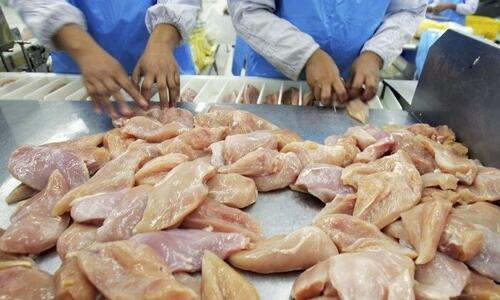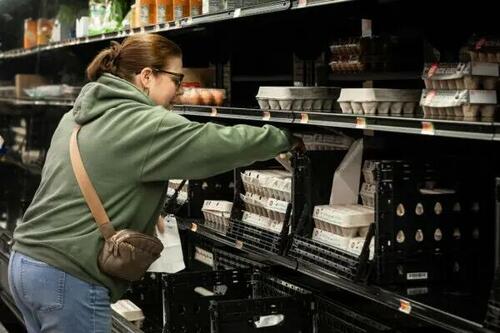
Why Aren’t Chicken-Meat Prices Rising Like Egg Prices?
Authored by Austin Alonzo via The Epoch Times,
The U.S. response to a highly pathogenic avian influenza is driving egg prices to record highs. Still, chicken meat prices remain relatively stable because of a significant difference in how the birds are raised and marketed.

Since 2022, the U.S. poultry industry has been heavily affected by its response to an ongoing outbreak of H5N1 highly pathogenic avian influenza (HPAI). In the 30 days up to Feb. 26, more than 19 million birds had been affected by HPAI outbreaks, according to the Department of Agriculture’s Animal and Plant Health Inspection Service.
The United States’ top egg-producing states—Iowa, Ohio, and Indiana—have lost more than 62 million birds because of culling since the beginning of the outbreak.
The latest Department of Agriculture Egg Markets Overview report, published on Feb. 21, placed the national average wholesale price of eggs at $8.07 per dozen. In some regions of the country, the average was nearly $10 per dozen.
The price of eggs has driven the Department of Agriculture (USDA) to step up its action in response to the crisis. On Feb. 26, Agriculture Secretary Brooke Rollins announced that the agency would spend as much as $1 billion to boost biosecurity on farms and compensate farmers who lost birds to HPAI. The USDA is also weighing the possibility of using vaccines to control the spread of the disease and taking steps to override state animal welfare laws.
Meanwhile, the average retail price of boneless, skinless, conventionally raised, frozen chicken breast meat, according to the USDA’s Agricultural Marketing Service’s weekly report for Feb. 15 through Feb. 21, was $2.99 per pound. Fresh, boneless, skinless breast meat was slightly more expensive, at $3.09 per pound. Boneless, skinless breast meat is the most popular cut in the U.S. market.
According to Consumer Price Index data published by the U.S. Bureau of Labor Statistics, the price of eggs rose by 53 percent between January 2024 and January 2025. During the same period, the average price of “fresh and frozen chicken parts” rose by just 0.8 percent.
The significant difference in price changes is due to multiple factors, including industry size, disease susceptibility, and market economics.
Agricultural economists who spoke with The Epoch Times earlier in February said the main reason egg prices are so high currently is the sheer number of birds being killed, because the virus was discovered in a flock. Additionally, egg farmers are hard-pressed to replace the lost birds because an egg-laying hen—known as a layer—takes several months to grow from a hatchling to a productive bird.
Layers of all ages are dying or being depopulated, leading to a long wait for farms to get back online.
Layers Versus Broilers
David Anderson, professor and extension specialist focused on livestock and food product marketing at Texas A&M University, told The Epoch Times that a number of farms raising birds to be slaughtered for meat—known as broiler birds—did suffer from HPAI outbreaks. Nevertheless, because of the way broilers are raised and processed, a much smaller number of birds were lost in those outbreaks.

A woman shops for eggs in Burlington, N.J., on Feb. 16, 2025. Samira Bouaou/The Epoch Times
Furthermore, Anderson said, the sheer scale of U.S. broiler production protects it from being decimated by HPAI mitigation. He said there were about 291 million layers in the United States as of Feb. 1. By comparison, Anderson said, about 796 million broilers were slaughtered for food in January.
Additionally, a broiler farm typically has about 200,000 birds on site when a flock is raised to market weight. By comparison, an egg farm can have millions of layer hens in a single complex. Recent data from the USDA’s Animal and Plant Health Inspection Service show that about 3 million birds were affected in a single outbreak in Darke County, Ohio, on Feb. 21.
“So the scale of production is really different,” Anderson said in an email. “So if we lose 300,000 broilers to bird flu, it’s not nearly as big a deal as the loss of an egg farm.”
Moreover, while layer birds can take months to reach productive maturity, a broiler flock typically reaches its market weight within six weeks.
Jada Thompson, associate professor of agricultural economics and agribusiness at the University of Arkansas, told The Epoch Times via email that the price of chicken has risen but that “it’s generally much more moderated” than the rapid increase in egg prices.
Additionally, the disease itself is showing signs of tending to spare broiler operations and punish layer operations.
Thompson said the strain of HPAI currently circulating in the United States is less likely to affect young birds, such as broilers, and more likely to affect older and longer-lived birds, such as layers and turkeys. The disease is also less likely to be transmitted in warmer climates. The U.S. broiler industry is heavily concentrated in the Southeast.
Elasticity
From a purely economic perspective, Jadrian Wooten, collegiate associate professor at Virginia Tech’s Department of Economics, said the relative stability of chicken meat prices during the HPAI crisis speaks to the elasticity of the U.S. chicken supply.
In this sense, Wooten told The Epoch Times, elasticity speaks to the industry’s ability to recover when losing a portion of its supply. If a broiler flock is lost, six weeks of production are lost, too. By comparison, if an egg flock goes, then four to six months of production go along with it.
Wooten said high prices usually command the market to make more products, which in turn drives the price down to an average level. Because of the U.S. egg supply’s inelasticity, this is not happening.
“[The broiler industry’s] ability to respond quickly means that when prices are going up, they’re not going to go up as fast,” Wooten said.
“But for hens laying eggs, because they’re not as responsive when prices go up … the price just keeps going up instead.”
Wooten said the rising price of eggs will test the elasticity of demand, too.
Typically, eggs are considered an inelastic product, meaning people will want and need to buy them no matter how high the price.
Wooten said he thinks eggs will prove their inelasticity because there are no good substitutes for them, especially for those who need them for recipes and other products. For now, Wooten said, the inelasticity of both egg demand and supply will keep driving prices upward.
* * *
Pick up a bucket of HEIRLOOM SEEDS (4,500 seeds spanning 39 varieties) from ZH Store! Use code THANKYOU10 for 10% off.
 Click pic… buy seeds… take food supply into your own hands…
Click pic… buy seeds… take food supply into your own hands…
Tyler Durden
Thu, 02/27/2025 – 12:40















